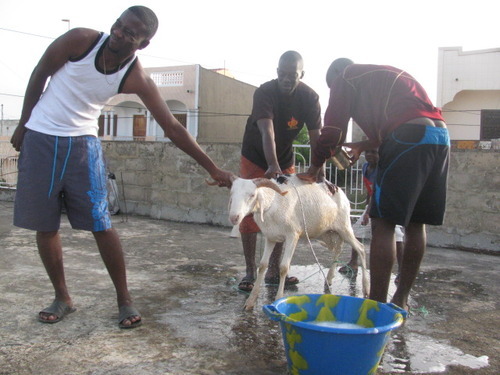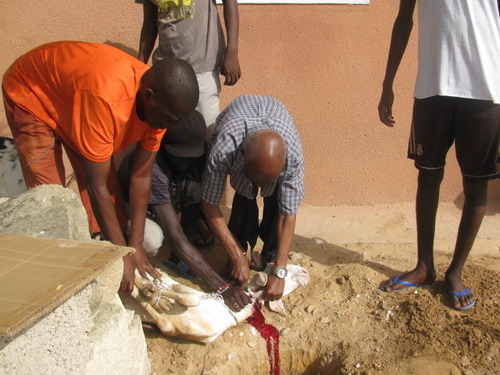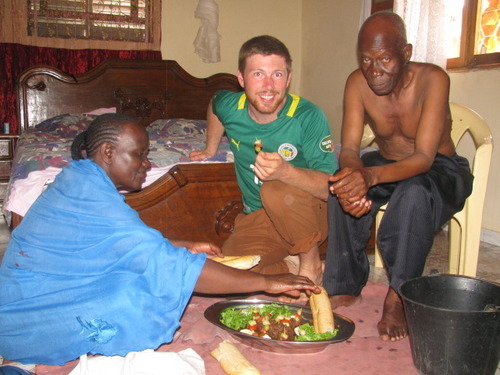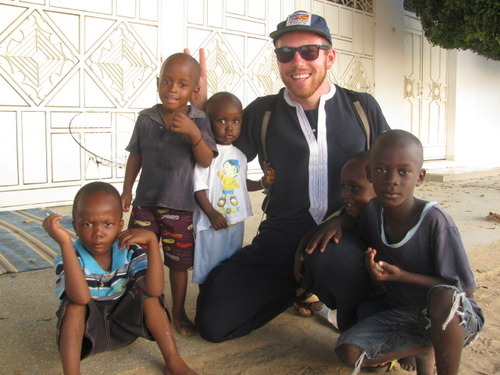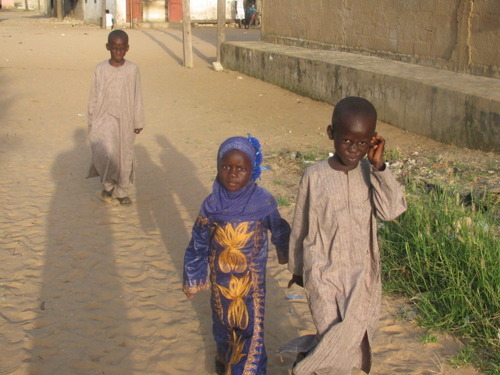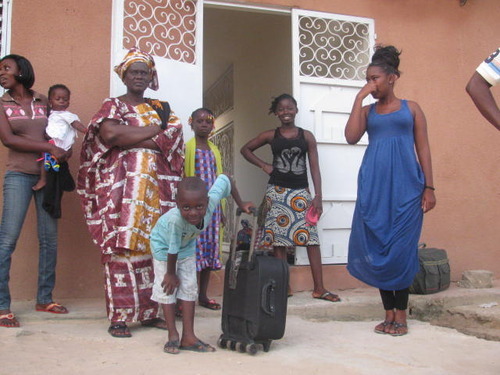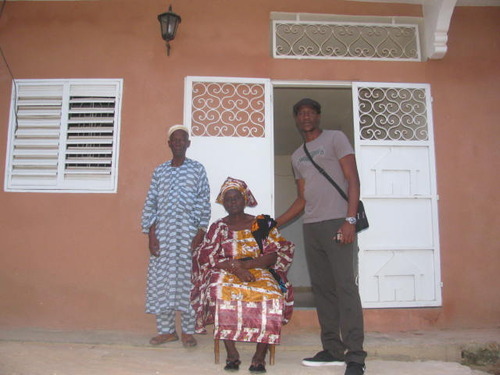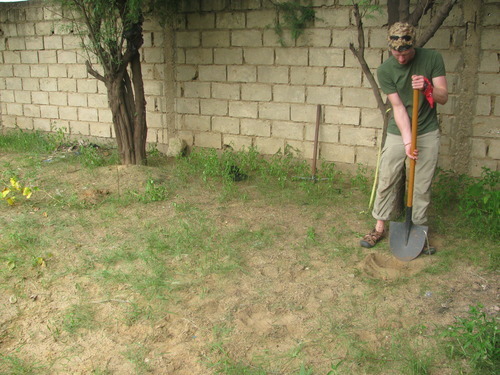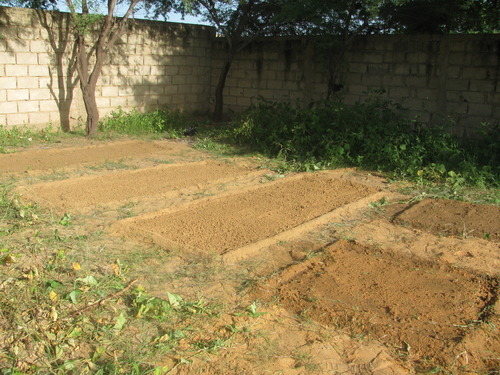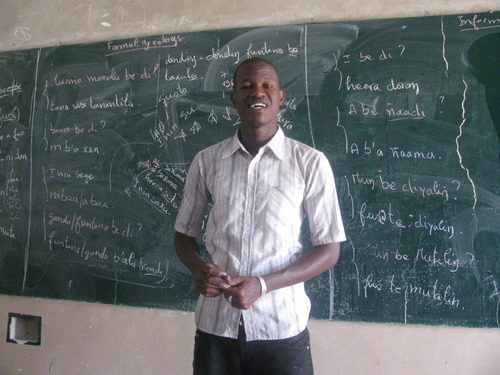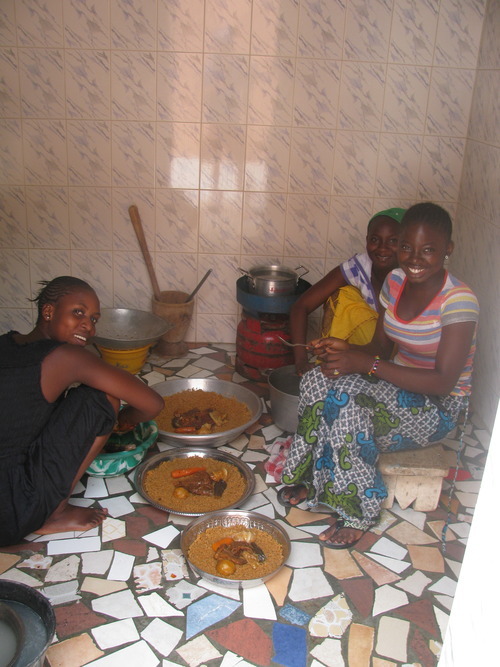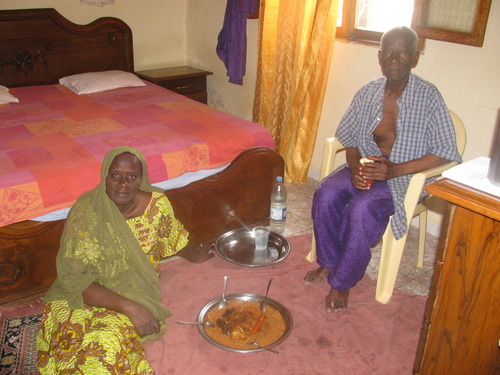Anyway, we were informed of our permanent site in a highly anticipated ceremony a couple weeks ago. I knew roughly where I would be going, because the language I have been learning—Jaxanké—is only spoken in the southeastern part of the country. But the specifics remained unknown.
All the volunteers in our training group were blindfolded, and then led to the approximate location of their sites on a large map of Senegal painted onto a basketball court at the training center. Then we stood there, blindfolded, waiting.
It was excruciating, and the country director Etienne Senghor[1] milked it for every moment he could with a prolonged, halted countdown to blindfold removal. I’ll never forget how I felt, sitting there, destiny momentarily hidden from me by a stupid blindfold. Which I will keep forever.
Finally, I took off the blind fold and looked down. The word Kédougou was printed on the pavement a foot or two in front of me and to my right. I was facing north, so this put me a bit southwest of the city, which is itself in the extreme south-eastern corner of the country.
 |
| Can you find Kédougou? |
What to make of that word? That place? In Jaxanké the word means "land/village of man". (Ké= man, Dugou= land/village) Instantly I wanted to know everything about it. I did a lot of research. I pored over the surprisingly limited information available on the internet. But it was still just a word until VV, (volunteer visit) which began the morning after the announcement.
VV may just be the best part of PST (pre-service training). You go down to your future site—the place that will soon be your home—and check it out with the current volunteer who is about to end his/her service, who you will replace. It is a taste of the language, environment, location and living/working conditions of the site. VV allows you to get an idea of what you are preparing for. However, since mine is a new site—a village that has never hosted a volunteer before—I was shown around by the closest currently serving Jaxanké speaking volunteer, a fine fellow from Florida named Chad Papa.
Driving down to Kedougou—the Gou—takes approximately 12 hours from Thies, including a stop for lunch and a couple snacks. So from Dakar, a common reference point, it would be about 13-14 hours. It is about as far as you can go without leaving the country.
The ride took us through the heart of the peanut basin, the geographic, and arguably cultural heart of Senegal. As with virtually all of Senegal, this land was at some point forested. Was it jungle? No, not within historic times. But as recently as 50 years ago it was a true forest of some kind, probably what ecologists call Guinean forest-savanna. Today it the forest has given way to pure savannah, going on sahel, even hinting at desert.[2]
The drive starts with a southeastern jaunt to Kaolack. This is not the sexiest part of the country[3]. (People know this, not trying to be inflammatory here.)
After Kaolack we turn almost due east, and hold this course all the way to Tambacounda. During this part of the drive, the landscape changes very gradually. While there is a west-east gradient with rainfall and other environmental/meteorological measures in Senegal, it is less important than the north-south climate gradient. It got slightly dryer as we drove east. The land is flat and pale, with some thorny scrub, lots of free-standing baobob trees, and kids driving donkey carts. A typical scene of the sahelian savannah. That's the peanut basin.
Peanut farming was first brought to this section of the country by the French, who forced their native subjects to grow peanuts used to feed their slaves in the Caribbean. Peanuts are to this day one of Senegal's biggest exports, and their cultivation is seen as a point of national pride. Massive swaths of land are farmed to this end in between Kaloack and Tambacounda. Yellow-white sand-dust covers almost everything visible from the road, despite it being shortly after the end of the rainy season. The grass, at least head high in most places is mostly yellow.
We pass through a few more cities, but population density drops off quickly the farther east you go. Kaffrine is busy, and less grungy than Kaolack. Koupentoum is very busy right along the road, but only the town only extends a couple of blocks into the sandy wastes beyond. There are PC volunteers in all of these cities, and I want to visit every one.
In Tambacounda, we turn south-southwest, and things start changing more rapidly. Soon we are passing through the major nature reserve of Senegal—Niokolo Koba National Park. As we drop latitude the the scrubby sahel vegetation thickens, and the trees get taller, bigger, and more plentiful. And gradually—gradually—the land hints at topography. In the park we see hundreds of baboons, and dozens of Guinea fowls. There are comparatively few megafauna species left around here[4], but lions, hyenas, warthogs, and bush-bucks are among those that remain.
As of about 5 years ago, the road to Kedougou is, officially, paved. The paved road now officially extends, all the way to Bamako, Mali. The completion of these roads was a significant achievement in West African road building. But they are completed only officially. Conditions on the ground do not completely correspond with the official narrative. Especially through the park.
For what I can tell, the two lane road was slapped down on top of the pre-existing dirt/laterite road, without any bedrock or foundational work. Just a slab of concrete on the old laterite road. Inevitably, drainage was ineffective, erosion was extensive, and the road came to have serious potholes. Some, I am told, got so big that if a car drove into one it could not get drive out. This led to a decision to pull out sections of the pavement wholesale, which apparently helped. Thus, some sections of the road are now unpaved, and the ones that are continue to have issues. The road map, however, (see above) shows a neat red line straight down to Kedougou.
It is a stomach churning drive. The Peace Corps employs excellent drivers, and our cars must be among the most comfortable in the country. This does not keep the section between Tamba and Kedougou, almost 4 hours, from being a formidable challenge in sitting skills. It was impossible not to notice, nonetheless, as the landscape suddenly became really beautiful.
Plains gave way to lush valleys, forested ridges, and sweeping river basins. The vegetation seemed succulent, almost tropical, and I had to gasp with delight when we passed the formidable Gambia river, charging out of the Guinean plateau on its way down into the Gambia. And the land is green as far as the eye can see.
Entering Kédougou City is not at once obvious. The scattered thatch roof huts that speckle the countryside surrounding the route to the city never really give way to a grand center with urban infrastructure and organized blocks of multistory buildings, sidewalks and glass storefronts. These things do exist to some extent, but only marginally. There is virtually no part of Kédougou City without wandering goats, thatched roofs, and unruly vegetation. And trash. Trash is everywhere.
 |
| Near the regional house in Kédougou |
Today, Kédougou is growing because of an ongoing gold rush focused mainly in the eastern part of the region, where Guinea, Mali and Senegal converge. The gold is found on the northern edge of the Guinean plateau, where the Futa Jallon mountains taper off amongst alluvial plains. Guinea, which home to the bulk of the mountain range, is believed to be well endowed with gold, and other valuable minerals. Their exploitation, however, has gone mostly unrealized. Politics, I guess. Maybe infrastructure. The New Yorker did an interesting piece on this last year, it is a complicated situation.
Along with mountains, Guinean culture also emanates into this region of Senegal. Many Senegalese people joke that everything south of Tambacounda is Guinea. These jokes do speak to some historical verité. In almost every every way-- besides politics-- Kedougou is more like Guinea than it is to the rest of Senegal.
For one thing, the term used to describe the ecology of the area is ‘Guinean savannah’[5]. The presence of mountains here is utterly unique in Senegal. The border roughly follows the edge of the Guinean plateau, leaving only the foothills and mountain edges in Senegal.
Most significantly, the common language on the streets of Kédougou city, unlike the majority of Senegal, is not Wolof. It is Pula Futa, or sometimes Malinké. (Malinké and Jaxanké are 99% the same thing) The Pula Futa are concentrated in the Futa Jallon mountains of Guinea, and the Malinké heartland are the plains of southern Mali/Eastern Guinea.
The cultural/economic links between the region of Kédougou and Guinea are manifold. The market is full of Guineans selling truckloads of avocados, kola nuts and other produce every week from the the tropical lands of their country.
It is not uncommon to see ‘Guinea buses’ descending from the hills south of the city packed full and loaded high on the roof with virtually everything imaginable; people, animals, produce, furniture, firewood, and luggage of all kinds.
These vehicles seem to occupy an area of legal ambiguity, as has much of the modern history of Kedougou- Guinea relations.
When Senegal became Senegal and Guinea became Guinea, a border was drawn right through a cultural continuum.[6] This suddenly made what was once something of a regular trip for many people illegal. It took the Senegalese state a while to do anything about this issue, though, being as it was in far flung provincial lands. Eventually, sometime in the 70's, a military base was built in Kedougou. This had alot to do with the immigration pressure created by the thousands of Pulaars fleeing across the border from Sekou Touré’s horrific governance in Guinea at that time. More on this later.
So the population of Kedougou is growing in response to the gold. But it is still very modest. Some people say it is ‘exploding,’ and I must contest this notion.
The reality is that most of the wealth is getting pulled right out of the ground and sent elsewhere.
The political and social issues of the gold mining industry in Kédougou are very complicated. Mining companies from all over the world are present here, and there is widespread contention regarding questions of justice.
The government of Senegal seems to favor and protect the large-scale operations, probably for the large heavy taxes/bribes they pay, while declaring small scale, artisanal mining legal only for Senegalese citizens. Many of artisanal miners are from nearby african countries, such as Burkina Faso, Côte D'Ivoire, Guinea, and Mali. These are countries that have experienced gold rushes in recent years, and the miners bring with them important knowledge on how to effectively mine gold on a small scale. This is knowledge that can actually empower individuals, and allow them to benefit by effectively extracting wealth from the gold mines. Banning these people is in effect anti-democratic, because it means only the large companies profit, while limiting the ability of the people to do so.
This also means the most of the wealth goes two places; The bank accounts of Canadian, British, Belgian and South African mining companies, and the coffers of
So, Kédougou is still basically a glorified village, and does not yet reflect the extensive mineral wealth of its lands. This is changing, but slowly.
We spent the first night in Kedougou getting to know the current Peace Corps Volunteerss in the region, the Gou crew. People I will undoubtably get to know well. The next morning Chad and I set out on bike for my village, Dar Salaam.[7]
Biking out of town you leave all signs of a urban life almost immediately. Fields and forests take over right away. The route to Dar Salaam, a ‘bush path,’ climbs up and over a few forested ridges, and snakes through grasslands and forest of varying density. No major terrain features, but I relished every little bit of topography and began scoping the environs immediately for other trails on which to mountain bike.
The closest village to Dar Salaam is a small Bassari Village. The Bassari are a tiny ethnic group found only in the southeast of Senegal. They are among the 8-10 percent of Senegalese that are animist/Christian. Palm wine trees feature heavily in their horticultural arrangement. I will have to introduce myself.
We also had to cross a seasonal creek called the Siling which flows from some hills to the west of Dar Salaam the west into the Gambia river. Dar Salaam is located around the convergence of these two waterways. Since it was still the rainy season, we could not take the ‘dry season path,’ which forges the creek when it is low/dry. Instead had to cross a few kilometers further upstream, across the infamous ‘stick bridge.’
 |
| Chad Papa with my new work partner, Mamadou Minté. |
Dar Salaam.
[1] Who is in fact a grandchild of the first president of Senegal, and negritude poet/novelist, Leopold Sedar Senghor.
[3] At some point in the past the Kaolack region was home to mangrove, and other kinds of lowland forests, occupying the extensive flood plains along and around the large, tidal Sine and Saloum rivers that pass through the region. These lands proved to be fertile, with easy fishing, and profitable harvesting of forest products. Overexploitation and other factors have made Kaolack into a pretty dumpy city today. I’ve heard it described as ‘sludgy’ because of the widespread pools of quasi-toxic standing water that form due to its proximity to swampy lowlands.
[4] Again, due to a variety of reasons.
[5] An ambiguous term. It is borderline rainforest. For half the year, during the rainy season, it is truly so. But the dry season lasts 4-5 months, and is very hot, and very dry. Things die off. Creeks and even wells sometimes run dry. The true tropical zone starts on the other side of the crest of the Futa Jallon, a couple hundred km south into Guinea.
[6] As borders inevitably are in the absence of a sustained homogenizing modernist political project. This is why they only make any sense at all in Europe.
[7] This is really confusing because it is one of a dozen or so Dar(ou) Saalams in Senegal and (I’d guess) hundreds in the world. It is probably the smallest out of all of them. But who wouldn’t name their village “House of Peace?”
